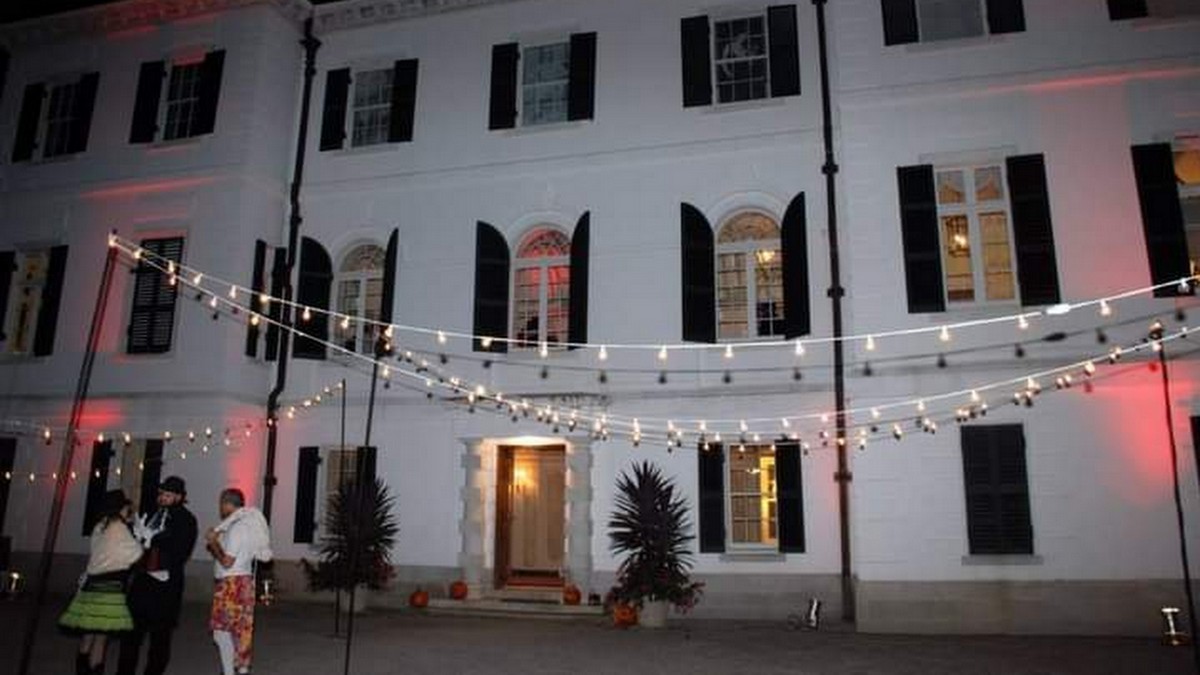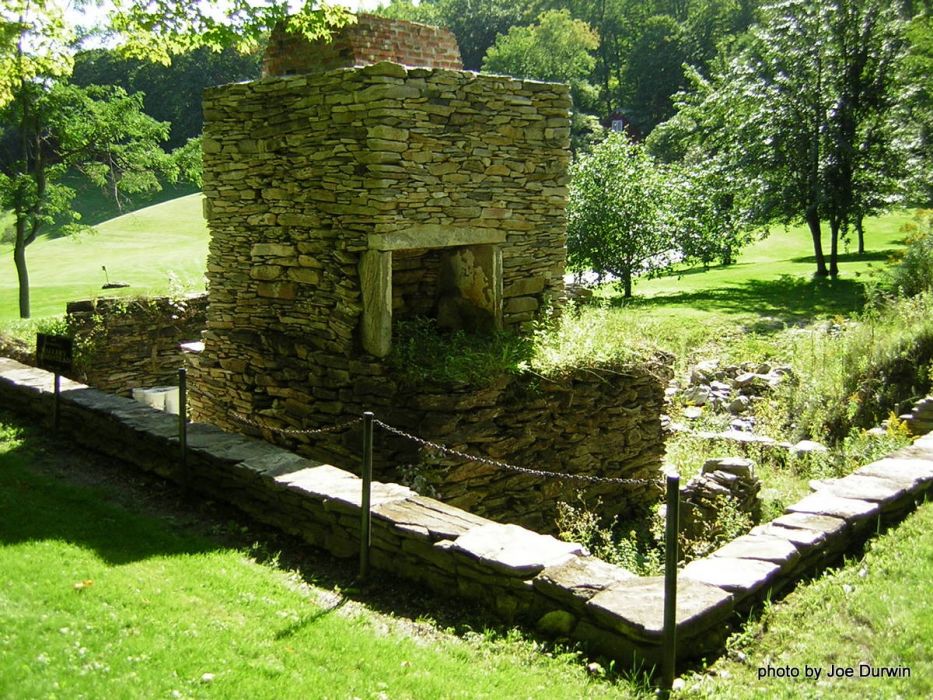

It’s interesting to me that some of the Gilded Age cottages that have come to be most associated with hauntings today — places like The Mount, Whistlers Inn, Ventfort Hall — weren’t at all among the early reputed “haunted houses” of the Berkshires of that era.
Instead, you have places like Greenwood — aka the Captain Britton place in Pittsfield — or Fernbrook, in Lenox.
Greenwood was an interesting early example. Thomas Britton built it in the late 1840s, on a hill near where Route 20 meets Barker Road. It was renowned as a place of hospitality, parties, part of a lively social scene. But Captain Britton died in 1855, and after the house passed to his daughter, who married Thaddeus Clapp, it was less and less used. The Clapps had it renovated extensively in 1875, but this moody house on the hill was already developing a reputation, and by the early 1880s there are outright newspaper references to it being haunted. In fact, The Berkshire Eagle said something interesting after it was reoccupied in 1884 — that “ghosts don’t come where real folks really live.” I think that captures a little bit of the cultural ideas of haunting that had begun to emerge by that time.
One of the most curious things about the haunting of Greenwood is that even after it burned down in 1890, people would still report seeing ghosts in the vicinity. In 1897, the Sunday Morning Call published a long story about workers who said they would see silhouettes of people floating by, over the hill and cresting over the old railroad bridge that still stands at the edge of Clapp Park today. A century after that, I was still finding vague mentions teenagers would leave on internet message boards about Clapp Park being haunted … seemingly without any knowledge of how far back ghost stories in that vicinity actually went.
In Lenox, tales of ghostly happenings at Fernbrook — what’s now called High Point — also dated back to right after the death of its original owner, in 1920. Fernbrook was built around the same time as the Mount, in 1901, by the famous sculptor Thomas Shields Clarke. One of its longtime caretakers, Robert Gorden, was able to flesh out some of these stories about it for me. From the time Dr. Metz took over the place in the ’20s, help at the house would talk about doors opening and closing on their own, and folks would hear a sound coming from the basement, like someone groaning or crying.
The story they told, which was passed on to Gorden by the next owner, was that a Welsh servant girl named Anghorad had gotten pregnant by Clarke, and died in the basement from complications. Some even said they thought they had seen a hint of the girl, out of the corner of their eyes. Today, students and staff of Hillcrest Educational Center who sleep in the old house are still telling stories of unexplained sounds and sights.
In addition to ghosts apparently loving good architecture and finer things, there were also emerging cultural ideas of hauntings being associated with tragic events, and with abandonment. In the early 20th century, we see examples of that also with the Mallery homestead in New Ashford, a widely reputed haunted house before it burned down in 1939, and the Fosburgh Mansion on Tyler Street, where May Fosburgh was murdered, finally demolished in the early ’50s. Both had been the site of violent deaths, and both sat abandoned for a number of years.
Of course, the fact that the Berkshires had for some time been this artistic and literary mecca also had some influence on this whole evolution of perceptions of ghosts, locally and worldwide. William Cullen Bryant was one of the first luminaries to tackle both homicide and spirit manifestation in American literature, in both cases inspired by local Berkshire legends. Much later, Edith Wharton and her friend Henry James would make some major contributions to that gothic subgenre. Not nearly as much so, perhaps, as our near neighbor up in North Bennington, Vt., Shirley Jackson. The “Haunting of Hill House” is without question one of the most influential “haunted house” novels ever written.
It’s a truly major shift in the ideas behind supernatural phenomena, in which things become much more about the location itself. It’s impact not only on horror and gothic fiction, but on “real life” folklore and approaches to paranormal study, has been vast.
Hill House itself is set somewhat vaguely in Massachusetts — the book is nonspecific — though later adaptations in 1999 and 2018 very clearly indicate it being in the Berkshires. And of course it was all written just 20 minutes north of the Berkshires, where Jackson drew from real reputed haunted houses in that area for inspiration.
She was something of an amateur ghost hunter herself, and her biographies speak of her cavorting around the area to visit houses she’d heard were haunted. The most significant influence — the true Hill House, to the extent there is one — seems to have been the Everett mansion at the foot of Mount Anthony in Bennington, which became part of the now defunct Southern Vermont College. But it’s not at all inconceivable she may have ventured south of Pownal in some of her haunting hunts.
In local folklore, though, the mid-20th century saw a bit of a drought in ghost stories, so much so that by the late 1950s one Eagle columnist remarked that the Berkshires didn’t seem to be fertile ground for such tales. Clearly he didn’t bother to look very far back, but it’s true that such talk had grown scarce at that time.
The mid-1900s had brought a new sense of modernity, and a modernity that took itself very seriously, perhaps too much so to dally with the spirit world. In the face of world wars, a depression, and a new nuclear age, such concerns may have seemed abstract. There were other horrors to consider as well — from the profusion of other spellbinding monsters on the silver screen, to the inscrutable new threat of flying saucer sightings and UFO abductions that touched down in the Berkshires in the ’40s-60s. Ghosts had become temporarily mundane.
One was Arthur Myers, who reported for The Eagle in the early ’60s and edited the Berkshire Sampler through most of the 1970s. Myers had an avid interest in these affairs, and his journalistic investigations churned interest in local mysteries and hauntings both locally and abroad. Myers published five works on the subjects of ghosts, including the “Ghostly Register,” “Ghostly American Places,” and “A Ghost-Hunter’s Guide.”
Meanwhile, in North Adams, professor Ali Allmaker was transferring from the physics to philosophy department at what was then North Adams State College, now Massachusetts College of Liberal Arts. There, he began teaching elective classes on parapsychology topics, from ESP (extrasensory perception) to hauntings. He also investigated in the field, an early pioneer in attempts to study hauntings in a more high-tech, systematic way. He employed motion detectors, Geiger counters, EMF detectors, thermometers and the like. The Hoosac Tunnel and the Park-McCullough House in North Bennington were among the hauntings he researched, as were a significant number of private residences whose identities were not revealed in his published articles.
.jpg)
The Houghton Mansion in North Adams was popularized on a number of ghost-hunting television shows but has since been sold and is no longer open for tours.
Then came the famed Ed and Lorraine Warren to the Berkshires, briefly, in 1981, when some of the most pronounced paranormal activity ever claimed in a local house was being reported in Lee. On a quiet residential side street, Dale and Lui Passetto Jr. and their family had been driven repeatedly from their home by a terrifying series of occurrences. It began on March 19, when the family saw an apparition of a small boy dressed in white. The boy spoke to them in a sweet voice, and was never threatening. Still, Lui decided it was best to have a priest come perform a blessing on the home.
After that, the Passettos said, things went berserk. Beds levitated. Objects were hurled. A stuffed dog belonging to their daughter came to life and chased her and her mother out of the house. The boy was replaced now with repeated visions of short, “demonic” creature in a black hooded robe. The Passettos were clawed, dragged out of bed, hit on the head with objects. Lee Police were called, arriving to find a 2,000-pound steel bookcase toppled and buckled, but did not witness any of the unexplained events personally.
The case spread from local to national media through the Associated Press, and soon it had attracted the attention of the Warrens in Connecticut. Ed and Lorraine, who had been investigating the supernatural for decades already, had recently been growing in notoriety as demonologists following their involvement in the events surrounding the “Amityville Horror” story.
At the Passetto house, the Warrens said they heard groaning voices and witnessed orbs of light combine into a ghostly figure before their eyes. They later stated that they then brought in an unknown priest to do another, more aggressive cleansing of the home [the Diocese of Springfield subsequently indicated none of their priests participated in any religious ritual at the house]. During the ritual, they said the basement filled up mysteriously with smoke; after that, no further activity was reported.
Plenty of media engagement followed, though, and the Passettos would retell their story again on national television for Oprah Winfrey, Geraldo Rivera, “Good Morning, America” and others over the next few years. At the time of this writing, the home where this all occurred is currently for sale.
In this century, the tradition of engaging para-realms from a technological angle that Allmaker had pursued lived on in the work of the Berkshire Paranormal Group, who emerged in the early 2000s hey-day of “ghost-hunting” television shows. Formed by a group of Masons at the Houghton Mansion in North Adams, BPG opened the reputedly haunted building up to all manner of tours, investigations and small paranormal conferences for several years beginning in 2004. They also investigated other local haunts, like the Butler Goodrich House and the Charlemont Inn.
Word spread through like-minded online communities and many new visitors flocked to the Berkshires from around the Northeast. National ghost-hunting shows began to take interest, filming shows at half a dozen locations over the next few years, most notably The Mount, which by the early 2010s had begun to fully embrace its emerging lore. Its October Ghost Tours have been extremely popular for years now.
Tanglewood (where ghostly happenings have been experienced at Highwood Manor, Seranak, and on the grounds … by some pretty famous people), we’re just waiting on you now.
This is an inescapable part of our regional history, identity, and cultural legacy. It’s impossible to predict how it will grow and evolve from here. But I’m excited to see it, and I’m thankful for all the various journalists and scribes who have continued to work this territory — from the departed Richard Happel, Clay Perry, Willard Douglas Coxey, to folks like Jennifer Huberdeau and Robert Oakes today — for helping to keep that legacy alive.
from WordPress https://ift.tt/3w3RULe
via IFTTT

No comments:
Post a Comment